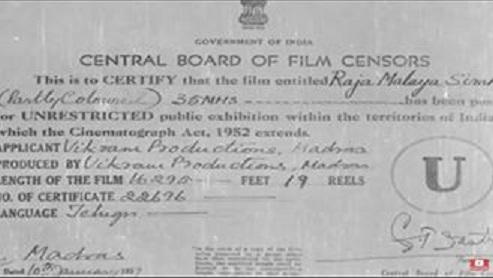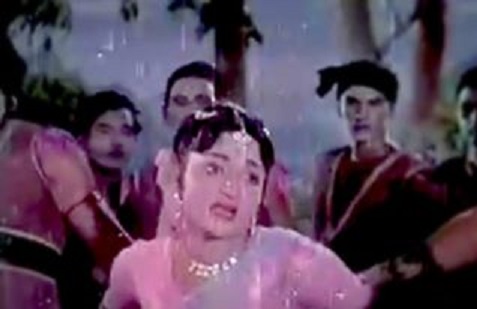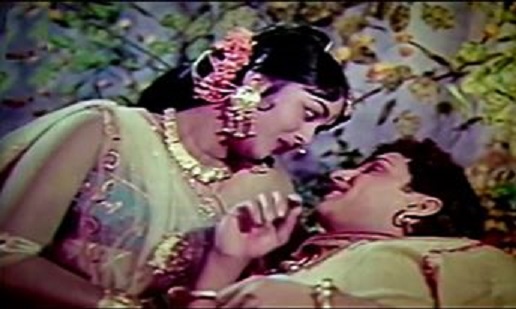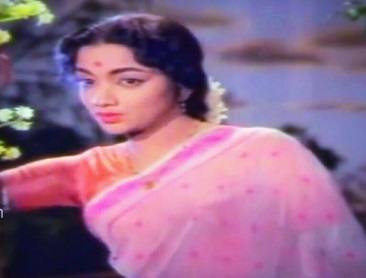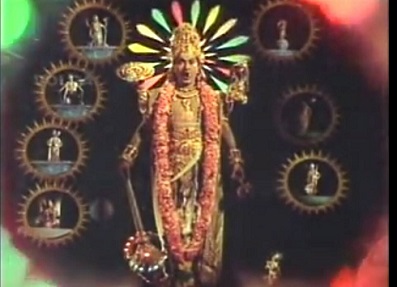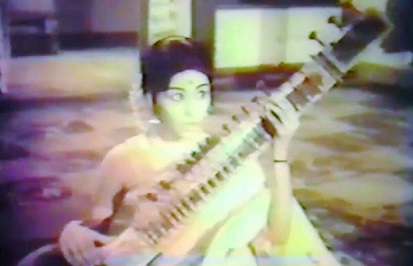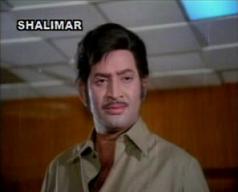Colour films in Telugu
(→Authorship) |
|||
| (7 intermediate revisions by one user not shown) | |||
| Line 1: | Line 1: | ||
| + | [[File: Lava Kusa Telugu 1963 for colour films.jpg| ''' Lava Kusa '''(Telugu/ 1963) was the first full-length Colour film in Telugu N. T. Rama Rao (Sri Rama, centre) is framed between Master Nagaraju (Lava) and Master Subrahmanyam (Kusa)<br/> |frame|500px]] | ||
| + | |||
| + | [[File: Raja Malaya Simha.jpg| ''Raja Malaya Simha '' (1959/Tamil and Telugu) <br/> The censor certificate of the film says that it was ‘partly coloured’|frame|500px]] | ||
| + | [[File: Bandipotu.jpg| Bandipotu (1963/ Telugu)|frame|500px]] | ||
| + | [[File: Amarashilpi Jakkanna.jpg|Amarashilpi Jakkanna (1964/ Telugu) |frame|500px]] | ||
| + | [[File: Tene Manasulu1.jpg|''Tene Manasulu '' (1965/Telugu) |frame|500px]] | ||
[[File: Veera Abhimanyu 1965 Tamil and Telugu.jpg| '' Veera Abhimanyu '' (1965/Tamil and Telugu) |frame|500px]] | [[File: Veera Abhimanyu 1965 Tamil and Telugu.jpg| '' Veera Abhimanyu '' (1965/Tamil and Telugu) |frame|500px]] | ||
[[File: Tahsindar Gari Ammayi1.jpg|''Tahsindar Gari Ammayi '' (1974/Telugu) |frame|500px]] | [[File: Tahsindar Gari Ammayi1.jpg|''Tahsindar Gari Ammayi '' (1974/Telugu) |frame|500px]] | ||
| − | [[File: | + | [[File: Eenadu (1982).jpg|Eenadu (1982) Telugu|frame|500px]] |
| − | |||
{| class="wikitable" | {| class="wikitable" | ||
|- | |- | ||
|colspan="0"|<div style="font-size:100%"> | |colspan="0"|<div style="font-size:100%"> | ||
| − | + | ||
| + | Readers can send additional information, corrections, photographs and even<br/> complete articles on new subjects to the Facebook page, [http://www.facebook.com/Indpaedia Indpaedia.com]. <br/> If found suitable, this additional information will be incorporated into the <br/> related Indpaedia article (with an acknowledgement) or a new entry will be<br/> created (also with due acknowledgement). | ||
</div> | </div> | ||
|} | |} | ||
| − | + | ||
| − | + | ||
=The pioneers= | =The pioneers= | ||
| − | + | ||
| − | + | ||
| − | + | ||
First ‘entirely in colour’ film: Lavakusa (1963/ GevaColor). | First ‘entirely in colour’ film: Lavakusa (1963/ GevaColor). | ||
| Line 37: | Line 41: | ||
Then where does this leave '' Eenadu '' (1982/ Telugu)? Nowhere. ('' Eenadu '' is claimed on the internet to be the first Telugu film in Eastmancolor) | Then where does this leave '' Eenadu '' (1982/ Telugu)? Nowhere. ('' Eenadu '' is claimed on the internet to be the first Telugu film in Eastmancolor) | ||
| + | =The early years= | ||
| + | ==From ‘Partly in Colour’ to Entire Film in Colour== | ||
| + | |||
| + | '''Allavuddin Adbhuta Deepam ''' (1957/ Telugu ) Partly in colour. Arguably the first Telugu film with any colour scenes at all. | ||
| + | |||
| + | '''Appu Chesi Pappu Koodu ''' (1958/ Telugu) Partly in colour | ||
| + | |||
| + | '''Deiva Balam ''' (1959/ Telugu) The second half and some other sequences were in Gevacolor. | ||
| + | |||
| + | '''Runanubandham ''' (1960/ Telugu) Partly in Gevacolor | ||
| + | |||
| + | '''Lava Kusa ''' (1963/ Telugu) This was the first full length Telugu film to be shot in colour, i.e. Gevacolor. | ||
| + | |||
| + | |||
| + | = Gevacolor= | ||
| + | |||
| + | ==Partly in Gevacolor== | ||
| + | A 1962 Telugu film, ''Aaradhana ''was partly in colour. The song "Oho oho Mavayya" was shot in Gevacolor. | ||
| + | |||
| + | [[Category:Cinema-TV-Pop|CCOLOUR FILMS IN TELUGU | ||
| + | COLOUR FILMS IN TELUGU]] | ||
| + | [[Category:India|CCOLOUR FILMS IN TELUGU | ||
| + | COLOUR FILMS IN TELUGU]] | ||
| + | |||
= Eastmancolor= | = Eastmancolor= | ||
| Line 122: | Line 150: | ||
[[IMAX in India]] | [[IMAX in India]] | ||
| + | |||
| + | [[Category:Cinema-TV-Pop|C | ||
| + | COLOUR FILMS IN TELUGU]] | ||
| + | [[Category:India|C | ||
| + | COLOUR FILMS IN TELUGU]] | ||
| + | |||
| + | [[Category:Cinema-TV-Pop|CCOLOUR FILMS IN TELUGU | ||
| + | COLOUR FILMS IN TELUGU]] | ||
| + | [[Category:India|CCOLOUR FILMS IN TELUGU | ||
| + | COLOUR FILMS IN TELUGU]] | ||
| + | |||
| + | [[Category:Cinema-TV-Pop|CCOLOUR FILMS IN TELUGUCOLOUR FILMS IN TELUGU | ||
| + | COLOUR FILMS IN TELUGU]] | ||
| + | [[Category:India|CCOLOUR FILMS IN TELUGUCOLOUR FILMS IN TELUGU | ||
| + | COLOUR FILMS IN TELUGU]] | ||
| + | |||
| + | [[Category:Cinema-TV-Pop|CCOLOUR FILMS IN TELUGUCOLOUR FILMS IN TELUGUCOLOUR FILMS IN TELUGU | ||
| + | COLOUR FILMS IN TELUGU]] | ||
| + | [[Category:India|CCOLOUR FILMS IN TELUGUCOLOUR FILMS IN TELUGUCOLOUR FILMS IN TELUGU | ||
| + | COLOUR FILMS IN TELUGU]] | ||
| + | [[Category:Pages with broken file links|COLOUR FILMS IN TELUGU | ||
| + | COLOUR FILMS IN TELUGU]] | ||
Latest revision as of 10:42, 14 July 2023
Readers can send additional information, corrections, photographs and even |
Contents |
[edit] The pioneers
First ‘entirely in colour’ film: Lavakusa (1963/ GevaColor).
Bandipotu (1963) was Telugu cinema's first film to have some sequences in Eastmancolor
Amarashilpi Jakkanna (1964/ Telugu) was Telugu Cinema's first full length colour film shot in Eastmancolor. The economics of using expensive Eastmancolor made sense because the 161-minute epic was simultaneously made in Telugu as well as Kannada. The film was directed by Ranga B.S. and Jakkanna was played by Akkineni Nageshwara Rao. Saroja Devi B. acted as his love interest.
Eenadu (1982) is supposed to be the first Eastmancolor film in Telugu. Maybe it was the first Eastmancolor film in Telugu alone (without a simultaneous version in another Indian language)
[edit] Milestones
First colour film: Lava Kusha (Geva Color) (1963)
First Eastmancolor film: Bandipotu (Partly coloured) (1963)
First full length Eastmancolor film: Amara Shilpi Jakkanna (1964)
First ‘social’ film in colour: Tene Manasulu (Eastmancolor) (1965)
Last film in Geva Color Tahsindhar Gari Ammayi (1974)
Then where does this leave Eenadu (1982/ Telugu)? Nowhere. ( Eenadu is claimed on the internet to be the first Telugu film in Eastmancolor)
[edit] The early years
[edit] From ‘Partly in Colour’ to Entire Film in Colour
Allavuddin Adbhuta Deepam (1957/ Telugu ) Partly in colour. Arguably the first Telugu film with any colour scenes at all.
Appu Chesi Pappu Koodu (1958/ Telugu) Partly in colour
Deiva Balam (1959/ Telugu) The second half and some other sequences were in Gevacolor.
Runanubandham (1960/ Telugu) Partly in Gevacolor
Lava Kusa (1963/ Telugu) This was the first full length Telugu film to be shot in colour, i.e. Gevacolor.
[edit] Gevacolor
[edit] Partly in Gevacolor
A 1962 Telugu film, Aaradhana was partly in colour. The song "Oho oho Mavayya" was shot in Gevacolor.
[edit] Eastmancolor
[edit] Partly in Eastmancolor
(The rest of the following films was in black and white)
Bandipotu (1963)
Veera Abhimanyu (1965)
Gudachari 116 (1967)
Poola Rangadu (1967)
Manasu Mangalyam (1969)
Bandipotu Dongalu (1969)
Mooga Nomu (1969)
Dharma Daata (1970)
Amayakural (1971)
Sri Krishna Vijayam (1971)
Ammma Kosam (1970)
Sisindri Chittibabu (1971)
Pavitra Hrudhayalu (1971)
[edit] Entire film in Eastmancolor
Ave Kallu (1967)
Bhakta Prahlada (1967)
Rahasyam (1967)
Vasantha Sena (1967)
Kalyana Mandapam (1971)
Prem Nagar (1971)
Sampoorna Raamaayanam (1971)
Sri Krishna Satya (1971)
Manchi Rojulu Vachayi (1972)
Andala Ramudu (1973)
Bhakta Tukaram (1974)
Krishnaveni (1974)
[edit] Authorship
Sajeeth Naveen Lourdes
created this page by sending photographs and facts as messages to the Facebook community, Indpaedia.com.
You can help by sending additional information (including anecdotes and the names of actors) to Indpaedia.com.
[edit] See also
Colour films in Telugu
CinemaScope films in Bangladesh, India, Nepal, Pakistan, Sri Lanka I.e. the first part of this article
70mm films in India/ South Asia

